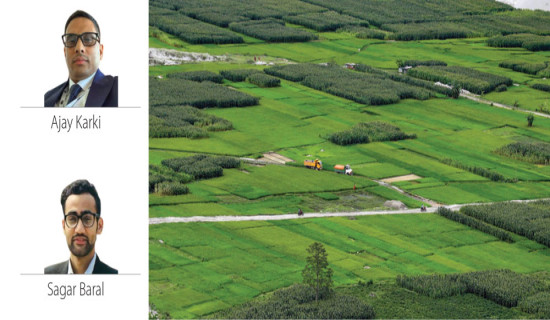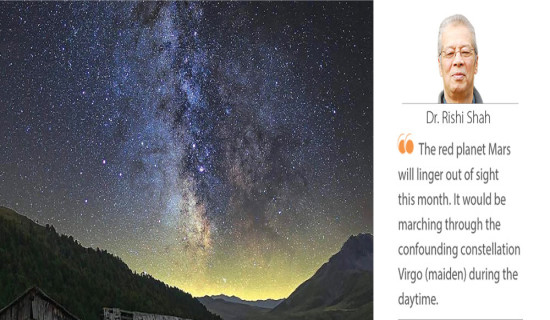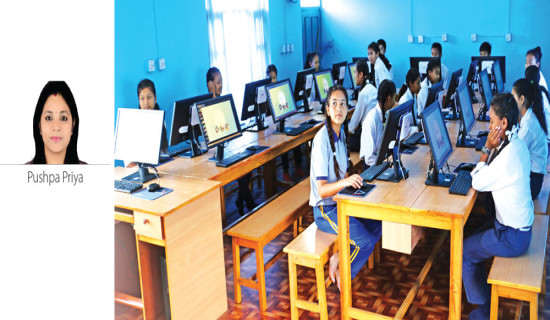- Sunday, 21 September 2025
Russia’s oil and gas revenues have recovered despite foreign pressure — PM
"Oil and gas revenues have recovered despite foreign pressure. According to data provided by the Finance Ministry, since September their trajectory has substantially exceeded last year’s level amid an increase in oil prices," he said at a meeting devoted to the draft federal budget for a three-year period.
Climate campaigners demonstrate in Kathmandu ahead of G20 summit
“We call on the G20 leaders to stop blocking progress towards a UN Tax Convention. It is a long standing demand of developing countries that the G20 and OECD have, time and again, stalled. We need a tax deal that centers the needs and concerns of the peoples of the Global South,”
Circular Economy for Business
In contrast to referring to waste with negative connotations, the circular economy is principally built on the notion of seeing waste as an opportunity and fundamentally focuses on life cycle extension strategies so that a product or its component can be turned back into the production and consumption cycle before its ultimate end-of-life.
I am positive about upgrading Jaleshwor customs as main transit: Finance Minister
Finance Minister Dr Prakash Sharan Mahat today said he was positive to upgrade the Jaleshwor customs office as a main transit for the expansion of trade relations with their countries.
PM Prachanda awards civil employees
The incumbent government awarded several civil employees for their performance par excellence on the occasion of 20th Civil Service Day today.
PM Prachanda urges investors to invest in Nepal
Prime Minister Pushpa Kamal Dahal 'Prachanda' today urged investors to invest in Nepal. Addressing the 12 Years of Investment Board Nepal ceremony on Friday PM Prachanda urged all valued potential investors to invest in Nepal.
Minister Devi directs government employees to be result-oriented
Minister for Federal Affairs and General Administration Anita Devi has directed civil servants to carry out result-oriented work. Addressing a programme organised here today on the occasion of the 20th Civil Service Day, the minister stressed the need for government workers to work professionally and creatively for development, prosperity and good governance.
Saturday Plein Air emerges platform for art enthusiasts
Last Saturday, about 15 artists were seen deeply engrossed in observing the heritage of Pachali Ghat in Teku. They were there to capture the cultural treasures on their canvases with each creating works from their unique perspective
Bill related to Federal Civil Service to be endorsed soon: PM Prachanda
Prime Minister Pushpa Kamal Dahal 'Prachanda' expressed his confidence that the Federal Civil Service Bill will be passed by the parliament as early as possible.
Thailand defeat Nepal in ICC Women's T20 World Cup Asia qualifier
Nepal have faced a defeat at the hands of Thailand in their first semi-final match played today under the ICC Women's Twenty-20 World Cup Asia Region qualifier.
One more arrested in connection with recent gold scam
One more person has been arrested for his connection with the recent gold scam. A team of the Department of Revenue Investigation had on July 19 seized 60.716 kg gold from Tribhuvan International Airport.
New Approach To Environmental Protection
As our planet grapples with the increasingly severe consequences of climate change, the urgency to rapidly transition towards achieving sustainable development goals has reached an unprecedented level. Governments worldwide are actively introducing a range of initiatives and policies to champion sustainable development.
Forgotten Medicines Of Nepal
An old truth used to say only that doctor is good who can cure the disease without a scalpel. Continuing this thought, the human body is so strong that it can overcome any disease. These are words that bear historical evidence of thousands of years of Ayurvedic medicines.
Autumn Sky Offers Celestial Delights
Dr. Rishi ShahThe night sky of this autumn month would provide sky-gazers with some spectacular sights of Jupiter and Saturn and their moons, along with copious celestial entities that could be spotted all over the heavens. On September 22, the elusive planet Mercury would reach its greatest western elongation from the Sun. This would be the best time to view Mercury since it will be at its highest point above the horizon in the eastern morning sky. Mercury could be marvelled at very shortly, towards the end of the month, in the eastern sky before sunup. Otherwise, it would be lost in solar glare as it would be too close to the sun. It would be mingling with stars that sketch the roaring constellation Leo (lion). Planet Venus could be visualised well early in the eastern sky at dawn. It would then fade out with the sunrise. It would be cavorting with the stars of the compact constellation Cancer (crab). The red planet Mars will linger out of sight this month. It would be marching through the confounding constellation Virgo (maiden) during the daytime. The stretch of glorious galaxies dubbed Markarian's Chain could bejewel the constellation Virgo. The binary star Spica (Chitra) would be scintillating serenely in Virgo. It would be utterly 250 light-years away. The giant planet Jupiter could be discerned late at night in the eastern sky. It would climb high in the southern sky after midnight. It would slowly sink towards the western horizon before daybreak. With its mesmerising moons, the giant planet would be located as a shiny speck in the sparse, sprawling section of the puny constellation Aries (Ram). Far-flung planet Uranus could be relished to the east of Jupiter in the late hours of the night as a fulgurating nib of light dwelling in the barren-akin expanse of the constellation Aries. It would be evanescent in the western sky in the morning. The ringed planet Saturn could be admired in the eastern sky after sundown. It would be ascending into the southern sky late at night. It would be sliding towards the western horizon before the day would commence. It could be recognised as a lambent light staying in the eastern segment of the charming constellation Aquarius (water bearer). The distant planet Neptune could be noticed in the eastern sky after sundown. It would be creeping high in the southern sky till the wee hours of the night. It would slip sluggishly towards the western horizon by day's end. The resplendent Neptune would be resting below the famed circlet-asterism of the rolling constellation Pisces (fishes). On September 19, the far-away giant planet Neptune will be in opposition. It would be nearest to Earth, and its face would be illuminated by the sun. It would be more intense than any other time of the year and would be visible all night long. It would be the most appropriate time to ogle and photograph Neptune. Since it is extremely far away, it would appear as a tiny blue dot in most professional telescopes. The new moon would be on September 15, while the full moon would be on September 29. Its popular sobriquet would be full corn or harvest moon, as the farmers would have harvested corn during this time of the year. This full moon would also fall closest to the September equinox each year. This moon would coincidentally be the last of four super moons in 2023. The moon would be sitting in immediate proximity to Earth and may seem slightly larger and brighter than usual. The September equinox would transpire on September 23, 2023. The sun would shine directly on the equator, and there would be almost equal amounts of day and night throughout the world. It would herald the first day of fall (autumnal equinox) in the Northern Hemisphere and the first day of spring (vernal equinox) in the Southern Hemisphere. The word equinox has been eponymously derived from the Latin words aequus (equal) and nox (night). Equinoxes occur because the so-called polar axis of the earth's spin has been tilted trickily at an angle of a paltry 23.5 degrees to the plane of the earth’s orbit around the Sun. The earth would hurtle around the sun once every 365.242 days, and this would describe the period over which the cycle of the earth's seasons would repeat from one year to the next. The precise position of the sun at the moment it passes over the equator on September 23, 2023, would lie in the constellation Virgo. The 8-day-old waxing gibbous moon would be 60 per cent full. Father’s Day will be observed on September 14. A colourful Teej ceremony, especially for women, would be celebrated on September 8. Rishi Panchami will be venerated on September 19. Kumari and Indra Jatra festivals will be revealed respectfully and with exuberance on September 28. The unmanned Chandrayaan-3, meaning moon craft in Sanskrit, had touched down successfully for the first time near the moon's uncharted South Pole. The Chandrayaan-3 mission has captivated public attention since its launch practically six weeks ago. Schoolchildren had followed the final moments of the landing through live broadcasts in classrooms. Chandrayaan-3 had traversed a more extended route to the moon than those taken by NASA’s Apollo crafts. For the venture, less powerful rockets than those utilised in the US had been deployed. Consequently, the probe had to rush around the earth several times to build up sufficient speed before embarking on its month-long journey. Lander Vikram, which would translate to valour in Sanskrit, had detached from its propulsion module and had been dispatching images after entering lunar orbit. The solar-powered, six-wheeled robotic rover Pragyaan (wisdom in Sanskrit) would explore the lunar topology meticulously and transmit data to control rooms over its two-week lifespan. India has been closing in on global space-faring nations such as the United States, Russia, and China by conducting many assignments at much lower costs. This latest trip has a frugal price tag of 74.6 million US dollars. The Indian Space Research Organisation (ISRO) will be sending off a crewed expedition into space by next year. Our romantic moon (alias Luna) is our earth’s only natural satellite and was allegedly formed 4.6 billion years ago, not long after the formation of Earth in our solar system. The moon is in synchronous rotation with the earth. The first uncrewed trek to the moon took place in 1959 by the Soviet Lunar Programme, while the first humans landed on the moon with US Apollo 11 in 1969. The moon’s diameter is 3475 kilometres across. It would glide around Earth from an average distance of 384.4 thousand kilometres in 27.3 days. Its mean surface temperature recorded would vary from minus 233 degrees Celsius to 123 degrees Celsius. The dark side of the moon has been a conundrum-akin myth. This is because the moon would rotate on its axis at the same time it would need to scamper around Earth. Hence, the same side would always be facing the earth. The opposite portion lurking away from Earth has been perceived by human eyes from spacecraft. The rise and fall of the tides on Earth would be a result of the moon’s tugs. There are two watery bulges in the earth due to the gravitational pull that the moon would exert: one on the side facing the moon and the other on the opposite side that would lie away from the moon. The moon has been drifting approximately 3.8 centimetres away from Earth annually. The moon has much weaker gravity than the earth due to its minute mass. One person would weigh one-sixth (16.5 per cent) of the weight of the earth. Since the moon is devoid of an atmosphere, it would be unprotected from cosmic rays, meteorites, and solar winds. Thus, tremendous temperature variations are obvious. The lack of atmosphere would insinuate that no sound could be heard on the moon, and the sky would always look pitch black. Quakes on the moon could have been caused by the gravitational attraction of the earth. A prevailing theory has stipulated that the moon was once part of Earth and was created from a chunk that had broken off due to a mysteriously huge object colliding with Earth when it was relatively young.(The author is an academician at NAST and patron of Nepal Astronomical Society or NASO)
CALL Reshapes Education
Pushpa PriyaRecent tremendous developments in technology and communication have not only brought about changes in globalisation but also in the instructional education system. Computer-assisted language learning (CALL) is one of the most effective learning tools for learning a language, especially English, for non-native EFL students with the help of computers, technology, and electronic devices. It is a learner-centred learning tool where learners have control over their learning. In other words, they can self-control the learning pace and have personal freedom of choice in selecting what and how to learn the contents. This type of engagement instills confidence in learners' linguistic abilities. Through an investigation, the researchers have revealed their conclusions regarding the effects of CALL on linguistic proficiency and vocabulary expansion. Particularly during online sessions during the COVID-19 epidemic, the usage of technology has been strongly recognised to favourably influence the teaching and learning process. It is frequently observed that teachers use it to instruct in a second or foreign language.Since it exhibits one's language competency, pronunciation, mass-facing abilities, confidence, and communication competence, teaching a second language like English in front of a crowd is not a cup of tea. One suitable strategy for assisting students in preventing public speaking anxiety is calling. This is achievable because it provides the students with knowledge and confidence through their participation in various assignments that instruct them on what to say and how to convey the assigned material. Learners succeed with the assistance of several interactive workshops and advice on the fundamentals of public speaking.Several benefits of CALL have been observed and identified by different researchers that give space and motivation to integrate computer-assisted language learning (CALL) in today’s teaching and learning process, especially for foreign or second language learning. It provides various classroom activities that may engage students in individual, group, and pair work. This makes learners more engaged, interactive, and participatory. By providing individualised and realistic tasks to learners through digital media, CALL helps students monitor their progress and development. Most importantly, it does not discriminate against learners based on gender or learning abilities. In addition, CALL can inculcate language skills and provide an immediate response. It also provides a space for learners to practise writing tasks that include not only essay writing but also research writing. Through spelling checkers and Grammarly, they can easily address their problems with solutions.CALL benefits can be observed in vocabulary learning too. Vocabulary extension is one of the major factors influencing language learning. Language proficiency cannot be achieved unless you are poor in vocabulary or word meaning. Vocabulary extension is more relatable to comprehending, analysing, and interpreting reading texts. Similarly, having a vocabulary extension helps the learners develop their writing and public speaking skills as well. Likewise, several practise exercises are displayed to help learners master grammar skills. It has made contextual learning easy and interesting through game-based teaching and learning. This is visually appealing, resulting in grasping the attention of the students towards learning in a fun way.However, CALL has a few drawbacks too. For example, it may bring about a digital divide where haves and have-nots will be vividly observed and discriminated against based on financial capability. Similarly, it may also bring difficulties for those who lack digital literacy. Little knowledge is dangerous, and it can be negatively perceived when any inexperienced teacher with no expertise develops teaching material. This may adversely influence the teaching and learning process. In addition, learners turned out to be unsocial. In comparison to its demerits, CALL has more merits and is therefore recommended for its integration into the teaching and learning sector, especially by the researchers who researched it.Considering the number of benefits of computer-assisted language learning (CALL), especially in the teaching and learning of second language acquisition, relatable teachers must adopt CALL as a teaching method to ensure the betterment of foreign language learners. The call can be one of the motivating tools for learners, as they may experience modernised language learning as opposed to the traditional teacher-centred method. The students may learn at their own pace and understand the contents more clearly than written texts on the whiteboard. In addition, it provides flexibility for learners to learn at any time. It may also facilitate the teacher's ability to teach diverse learners with different learning abilities since different levels of exercises are available on the internet. In this way, both students and teachers may not fall victim to stress and anxiety. The chance for learners to compete in a global marketplace and enter a global community is high.CALL as a teaching method is of paramount significance, especially for the linguistic development of learners of a second language, and therefore is highly recommended to help learners face global challenges, competitiveness, and global community. However, in the context of Nepal, some of the teachers are not acquainted with the term CALL as one of the effective tools for language learning. Curriculum designers, education policymakers, and the government of Nepal should generate awareness about the usefulness of CALL in the teaching and learning process. In addition, the government of Nepal should educate or train teachers to implement technology-based education for the holistic development of teachers and learners.(The writer is a lecturer of English at Global College of Management)

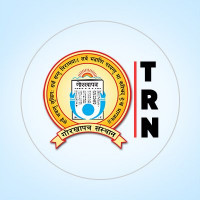



-original-thumb.jpg)
-original-thumb.jpg)

-original-thumb.jpg)

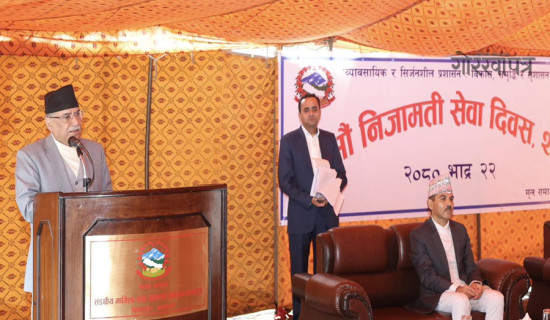
-original-thumb.jpg)

